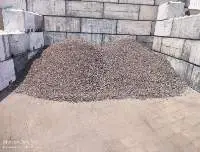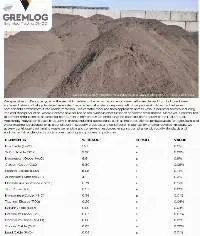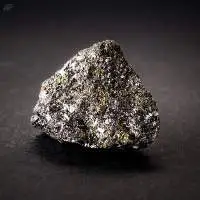

Bath Material is the electrolyte used in the Hall-Haroult process to produce primary aluminium. It's also known as Secondary Cryolite, Crushed Bath, Bath Cryolite, Pure Bath, Bath and tapped Bath Material. During the aluminium smelting process, surplus Bath Material can be generated because of high Sodium (Na) content in the alumina. This surplus is tapped in a liquid form and then crushed to be reused to start up new pots or to compensate for electrolyte losses. Bath Material can also be used in aluminium scrap recycling as well as in a number of other processes such as in the manufacture of glass, enamel, ceramics and more. Gremlog Offers Cryolite in the following sizes : 0-5 mm; 5-20 mm; 20-40 mm ; 0-40 mm
We specialize in offering recycled mill scale, which refers to the reclaimed or repurposed mill scale derived from hot rolled steel surfaces. Instead of being discarded as waste, this recycled mill scale undergoes meticulous processing to extract valuable components or transform it into usable materials. This versatile resource finds application across various industrial sectors, including iron and steel production, where it serves as a source of iron oxides in blast furnaces or electric arc furnaces. Moreover, it contributes to cement production as an essential component in cement clinker, enhancing the chemical composition of the final product. Additionally, recycled mil scale finds utility in diverse industrial applications, such as the production of ferrous sulfate for agricultural and water treatment purposes, or as a constituent in specialty products and construction materials. By offering recycled mil scale, we actively contribute to minimizing waste generation and conserving resources, ensuring compliance with quality standards and environmental regulations through proper handling and processing protocols.
We specialize in offering recycled mill scale, which refers to the reclaimed or repurposed mill scale derived from hot rolled steel surfaces. Instead of being discarded as waste, this recycled mi l scale undergoes meticulous processing to extract valuable components or transform it into usable materials. This versatile resource finds application across various industrial sectors, including iron and steel production, where it serves as a source of iron oxides in blast furnaces or electric arc furnaces. Moreover, it contributes to cement production as an essential component in cement clinker, enhancing the chemical composition of the final product. Additionally, recycled mil scale finds utility in diverse industrial applications, such as the production of ferrous sulfate for agricultural and water treatment purposes, or as a constituent in specialty products and construction materials. By offering recycled mil scale, we actively contribute to minimizing waste generation and conserving resources, ensuring compliance with quality standards and environmental regulations through proper handling and processing protocols.
This by-product derives from the iron industries and its a valuable material for melting and manufacturing of ferrock for construction purposes. As a leading supplier of eco-conscious materials, we take pride in offering a diverse range of recycled materials, including cryolite, carbon anodes, carbon dust, bath material, steel scrap, fine iron scrap, rebars and more. With a strong commitment to sustainability, our materials are engineered to meet the demanding needs of industrial projects while promoting environmental responsibility.
We specialize in offering recycled mill scale, which refers to the reclaimed or repurposed mill scale derived from hot rolled steel surfaces. Instead of being discarded as waste, this recycled mi l scale undergoes meticulous processing to extract valuable components or transform it into usable materials. This versatile resource finds application across various industrial sectors, including iron and steel production, where it serves as a source of iron oxides in blast furnaces or electric arc furnaces. Moreover, it contributes to cement production as an essential component in cement clinker, enhancing the chemical composition of the final product. Additionally, recycled mil scale finds utility in diverse industrial applications, such as the production of ferrous sulfate for agricultural and water treatment purposes, or as a constituent in specialty products and construction materials. By offering recycled mil scale, we actively contribute to minimizing waste generation and conserving resources, ensuring compliance with quality standards and environmental regulations through proper handling and processing protocols.
We specialize in offering recycled mill scale, which refers to the reclaimed or repurposed mill scale derived from hot rolled steel surfaces. Instead of being discarded as waste, this recycled mi l scale undergoes meticulous processing to extract valuable components or transform it into usable materials. This versatile resource finds application across various industrial sectors, including iron and steel production, where it serves as a source of iron oxides in blast furnaces or electric arc furnaces. Moreover, it contributes to cement production as an essential component in cement clinker, enhancing the chemical composition of the final product. Additionally, recycled mil scale finds utility in diverse industrial applications, such as the production of ferrous sulfate for agricultural and water treatment purposes, or as a constituent in specialty products and construction materials. By offering recycled mil scale, we actively contribute to minimizing waste generation and conserving resources, ensuring compliance with quality standards and environmental regulations through proper handling and processing protocols.
We specialize in offering recycled mill scale, which refers to the reclaimed or repurposed mill scale derived from hot rolled steel surfaces. Instead of being discarded as waste, this recycled mi l scale undergoes meticulous processing to extract valuable components or transform it into usable materials. This versatile resource finds application across various industrial sectors, including iron and steel production, where it serves as a source of iron oxides in blast furnaces or electric arc furnaces. Moreover, it contributes to cement production as an essential component in cement clinker, enhancing the chemical composition of the final product. Additionally, recycled mil scale finds utility in diverse industrial applications, such as the production of ferrous sulfate for agricultural and water treatment purposes, or as a constituent in specialty products and construction materials. By offering recycled mil scale, we actively contribute to minimizing waste generation and conserving resources, ensuring compliance with quality standards and environmental regulations through proper handling and processing protocols.
We specialize in offering recycled mill scale, which refers to the reclaimed or repurposed mill scale derived from hot rolled steel surfaces. Instead of being discarded as waste, this recycled mi l scale undergoes meticulous processing to extract valuable components or transform it into usable materials. This versatile resource finds application across various industrial sectors, including iron and steel production, where it serves as a source of iron oxides in blast furnaces or electric arc furnaces. Moreover, it contributes to cement production as an essential component in cement clinker, enhancing the chemical composition of the final product. Additionally, recycled mil scale finds utility in diverse industrial applications, such as the production of ferrous sulfate for agricultural and water treatment purposes, or as a constituent in specialty products and construction materials. By offering recycled mil scale, we actively contribute to minimizing waste generation and conserving resources, ensuring compliance with quality standards and environmental regulations through proper handling and processing protocols.
We specialize in offering recycled mi l scale, which refers to the reclaimed or repurposed mil scale derived from hot roled steel surfaces. Instead of being discarded as waste, this recycled mi l scale undergoes meticulous processing to extract valuable components or transform it into usable materials. This versatile resource finds application across various industrial sectors, including iron and steel production, where it serves as a source of iron oxides in blast furnaces or electric arc furnaces. Moreover, it contributes to cement production as an essential component in cement clinker, enhancing the chemical composition of the final product. Additionaly, recycled mil scale finds utility in diverse industrial applications, such as the production of ferrous sulfate for agricultural and water treatment purposes, or as a constituent in specialty products and construction materials. By offering recycled mil scale, we actively contribute to minimizing waste generation and conserving resources, ensuring compliance with quality standards and environmental regulations through proper handling and processing protocols.
We specialize in offering recycled mi l scale, which refers to the reclaimed or repurposed mil scale derived from hot roled steel surfaces. Instead of being discarded as waste, this recycled mi l scale undergoes meticulous processing to extract valuable components or transform it into usable materials. This versatile resource finds application across various industrial sectors, including iron and steel production, where it serves as a source of iron oxides in blast furnaces or electric arc furnaces. Moreover, it contributes to cement production as an essential component in cement clinker, enhancing the chemical composition of the final product.Additionaly, recycled mil scale finds utility in diverse industrial applications, such as the production of ferrous sulfate for agricultural and water treatment purposes, or as a constituent in specialty products and construction materials. By offering recycled mil scale, we actively contribute to minimizing waste generation and conserving resources, ensuring compliance with quality standards and environmental regulations through proper handling and processing protocols.
Our Bath Material goes beyond primary aluminum production, finding applications in aluminum scrap recycling and various industrial processes. Whether you're involved in glass, enamel, ceramics manufacturing, or other industries, our Bath Material proves to be a versatile and valuable resource. Explore the high-quality Bath Material solutions offered by Gremlog , providing excellence in electrolyte materials for diverse industrial application Discover the versatility of our cryolite offerings, available in a range of sizes tailored to meet diverse industry requirements. Our commitment to precision and customization ensures that our high-quality cryolite aligns seamlessly with the specific needs of your aluminum smelting processes, providing optimal performance and efficiency.Choose from our meticulously graded sizes, including : 0-5 mm; 5-20 mm; 20-40 mm; 0-40 mm; 5-40 mm;
Dead burned magnesite 97% is a chemical substance, which means that when magnesite is calcined at 1800C, carbon dioxide completely escapes, and magnesium oxide forms a dense block of periclase. This dead burned magnesite has a high degree of fire resistance. Its main component is magnesia, which is made of natural special magnesite magnesia through flotation purification, light burning, fine grinding, high pressure ball pressing, and ultra high temperature oil shaft kiln calcination. Application: Dead burned magnesite 97% are made from sorted super grade natural magnesite through sections including float concentration, calcination, fine grinding, high pressure briquetting and ultra high temperature sintering in heavy oil shaft kilns. They are good quality materials for making magnesia bricks and monolithic refractories. Packing: Jumbo bag(or according to the customer requirement)
When naturally occurring magnesium carbonate(magnesite) is fired at around 800-1500 it becomes what is known as ''caustic calcined magnesite''. The resulting magnesium oxide grains have the outer form of the magnesium carbonate and depending on the firing temperature are porous and more or less reactive due to their large inner surface area. It's also called industrial grade caustic calcined magnesite Application: In the production of magnesium salt, MgO oxide is used as raw material to react with acid. In Refractory, Mgo is used as the Refractory of crucibles. In energy plants, MgO is used to remove sulfur trioxide that are harmful to plants and the environment. In the rubber and plastic industry, Mgo is used as Filler, acid acceptor, anti-coking component and curing acid. Packing: 50kg pp bag with PE coating outside/ PE inner bag, 1250kg Jumbo bag.
This by-product derives from the iron industries and its a valuable material for melting and manufacturing of ferrock for construction purposes. As a leading supplier of eco-conscious materials, we take pride in offering a diverse range of recycled materials, including cryolite, carbon anodes, carbon dust, bath material, steel scrap, fine iron scrap, rebars and more. With a strong commitment to sustainability, our materials are engineered to meet the demanding needs of industrial projects while promoting environmental responsibility.
This by-product derives from the iron industries and its a valuable material for melting and manufacturing of ferrock for construction purposes.As a leading supplier of eco-conscious materials, we take pride in offering a diverse range of recycled materials, including cryolite, carbon anodes, carbon dust, bath material, steel scrap, fine iron scrap, rebars and more. With a strong commitment to sustainability, our materials are engineered to meet the demanding needs of industrial projects while promoting environmental responsibility.
Zinc ore is most commonly found as zinc carbonate (ZnCO3), known as calamine or smithsonite. It generally occurs as rounded, crystalline crusts or granular, honeycombed masses that have a vitreous or pearly luster and are typically dirty brown or grey in colour. Zinc is a chemical element with the symbol Zn and atomic number 30. Zinc is a slightly brittle metal at room temperature and has a shiny-greyish appearance when oxidation is removed. It is the first element in group 12 (IIB) of the periodic table. In some respects, zinc is chemically similar to magnesium: both elements exhibit only one normal oxidation state (+2), and the Zn2+ and Mg2+ ions are of similar size. Zinc is the 24th most abundant element in Earth's crust and has five stable isotopes. The most common zinc ore is sphalerite (zinc blende), a zinc sulfide mineral. The largest workable lodes are in Australia, Asia, and the United States. Zinc is refined by froth flotation of the ore, roasting, and final extraction using electricity (electrowinning). Item Specification LE: 60.244% Zn: 32.767% Pb: 4.403% Fe: 2.244% Ti: 0.225% Hf: 0.073% V: 0.03% Zr: 0.014% Moisture: >3
The main copper sulphide minerals are chalcopyrite (CuFeS2) chalcocite (Cu2S), covellite (CuS), bornite (Cu5FeS4), tetrahedrite ((Cu,Fe)12Sb4S13) and enargite (Cu3AsS4). The largest source of copper is from porphyry ore deposits in which one or a combination of the minerals occurs. A typical copper sulphide ore contains various levels of iron sulphide types that generally include pyrite (FeS2) and pyrrhotite (Fe1-xS). Often gold and silver are present which may either be associated with the sulphides or are free. The gangue particles can consist of a range of silicate minerals from quartz to talc and clays. Item Specification CR2O3: 42% Basis: 40% Min CR/FE Ratio: 1.35:1 MGO: 14% Max AL2O3: 16% Max SIO2: 10% Max P: 0.01% Max S: 0.01% Max Size 0-2 MM: (95% Min) Moisture at 105C or 110C: 8% Max















